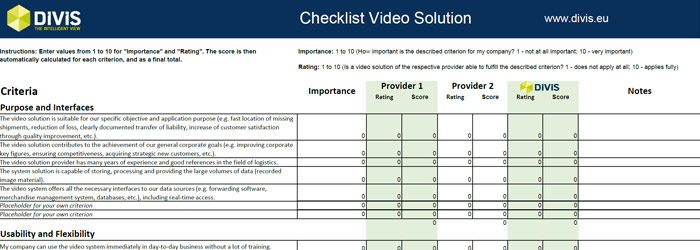DIVIS PRODUCTS
Digital process optimisation in logistics
Five steps to find the right video system for the logistics hall

Bordesholm, August 1, 2021
The demands on modern logistics processes are constantly increasing. In addition to greater safety on the premises, process optimization is at the top of the list of priorities in many places. For example, service quality and thus customer satisfaction must be increased, costs must be controlled effectively, and the criteria for industry certifications must be met. One of the key factors is the type of video system that companies use for their logistics hall. The market offers very different solutions here - from pure video surveillance to multifunctional video management systems. The following five steps help companies streamline the selection process and find the right solution for their needs.
Modern software combined with high-quality optical hardware offers a wide range of possible applications. Classic video surveillance systems focus on the issue of security. In contrast, there are solutions that go beyond theft prevention and enable comprehensive image-controlled process management in the hall. Selecting the right video system from the wide range of available solutions with very different specifications is not a trivial task.
With the following five steps, companies can speed up the selection process and take into account all relevant aspects:
Step 1: Define and prioritise the objectives.
First, define the overall business goals you want to achieve with the help of the video system:
- Do you want to permanently increase the level of security on the premises?
- Are you aiming at greater customer satisfaction and thus remaining competitive in the long term?
- Or is the focus set on increasing the quality of services and improving your company's reputation?
The operational goals result from the strategic goals. The latter are actual process optimisations that contribute to the achievement of a strategic goal. Record your operational goals in detail and prioritise them. It makes sense to initially tackle two to three goals. The subsequent goals should also be considered according to their priority when comparing the systems. It is important to ask in which areas the software is to be used and what improvements should result from it:
- Is your goal to find missing shipments faster?
- Do you strive for clearly documented transfer of liability?
- Are you looking to sustainably reduce the loss ratio?
Step 2: Define the scope of features and services.
The corresponding must-have and can-have features of the video solution are derived from the objectives defined in the first step. A central criterion here is also the degree of digitisation:
- Which interfaces need to be in place to integrate the video system with all relevant data sources - such as shipping software, merchandise management system, databases?
- Is the video solution capable of processing large amounts of data securely and delivering it fast for retrieval?
In addition to looking at the features, it is important to compare the providers in terms of support and experience:
- To what extent should the company's own IT department take over software administration and where is support from the service provider required?
- Do the providers in question have references that demonstrate their experience in similar use cases?
Step 3: Compare the solutions in terms of user-friendliness and flexibility.
Logistics is a fast-paced industry. To keep operations running smoothly, it is important that employees grow familiar with the new solution quickly. The effort required for familiarisation should be as low as possible. The following questions will give you an impression of usability:
- Is the video management software designed to be user-friendly and can the various modules and functions be accessed intuitively? For example, is it easy to find the image recordings of a particular shipment - even without knowing the individual camera positions?
- How extensive and practical are the display and processing options for the image material (e.g. full screen and zoom, 360-degree view, data export)?
- Can repeating work steps, such as the search for missing shipments, be seamlessly integrated into existing workflows?
The expandability of the functional scope cannot be underestimated as a criterion. Modular systems offer sufficient room for adjustments in response to changing conditions. The system should be ready for flexible expansion with additional features, such as scanner location, data analyses for process optimisation, etc. In this way, companies can quickly adapt their solution to new requirements.
Step 4: Maintain data privacy.
Compliance with data protection regulations in the logistics hall has been a topic not only since the DSGVO (Basic Data Protection Regulation). The requirements for a video solution range from legally mandatory storage periods to safeguarding employee rights when recording and processing the video material. If logistics companies also want to have their services certified according to national and international security standards such as TAPA, AEO, or s.a.f.e., the video system must also meet the corresponding criteria. In order to be DSGVO-compliant, providers should be able to answer the following questions, among others, with yes:
- Is the system protected from tampering and interference at all times?
- Is the user administration password-based? Are there individual authorization levels to control access to certain data?
- Can the image data be hosted on the company's own server?
- If it is a cloud solution: Does the provider take comprehensive measures to ensure that the information is protected from unauthorised access?
In the event of an evidentiary situation, the video system should also be able to provide recordings of the logistics hall that can be used in court.
Step 5: Plan the implementation.
The budget and the implementation period play a central role in the cost-benefit assessment. To ensure that the switch to the new solution runs smoothly, it is important to coordinate closely with the provider and plan precisely together. To avoid downtime, the installation should be able to take place during ongoing operations. Even with the most thorough preparation, however, unforeseen hurdles sometimes arise. That's why the provider should continue to guarantee fast support in the first few weeks after go-live. Ask targeted questions already during the selection phase:
- Is it possible to implement the video system during operation?
- What temporary limitations on operational processes can be expected during this time?
- Do you have an assigned contact person throughout the planning and implementation?
- Is the support easy to reach and which response times are guaranteed?
- Which options are available for support, consulting and supervision after implementing?
Once these points have been clarified, you will already have a concrete idea of how the introduction of the video solution will take place - and have sufficient planning certainty for the project.
Conclusion
Which video solution will be the best match also depends on the size of the company. Corporations with numerous locations need a provider whose products can be used in halls of any size - and who can also take into account the requirements of the works council, for example. In contrast, a medium-sized logistics company will focus on other aspects, such as the integration of existing technology into the new video system. Regardless of the particular circumstances, anticipatory planning is indispensable. The more precisely and comprehensively the video system addresses the respective pain points in the hall, the more effectively it reduces operating costs. From the clear documentation of the transfer of liability to the reduction of the loss and damage rate and the clarification of incorrect loading - effective process optimisations help to ensure that the investment is quickly amortised. In this way, a video solution that is prepared to meet tomorrow's needs today provides a long-term competitive advantage and secures the company's future success.

Selection process checklist
To help you define your own requirements for the video management software, we provide a practical checklist in Excel format to logistics companies.













